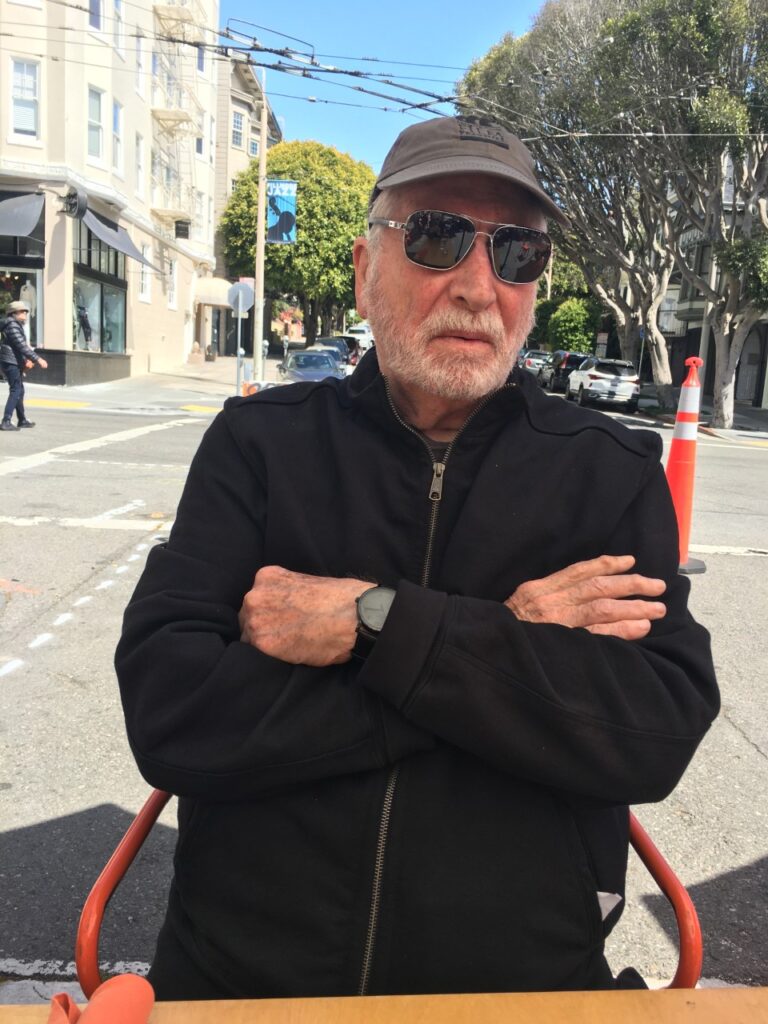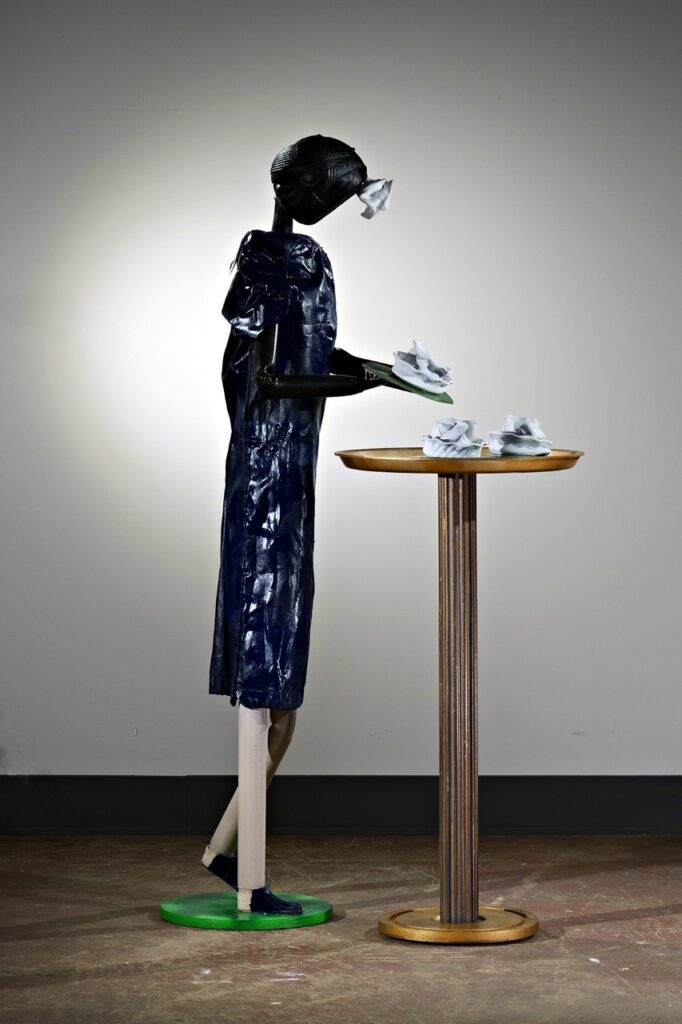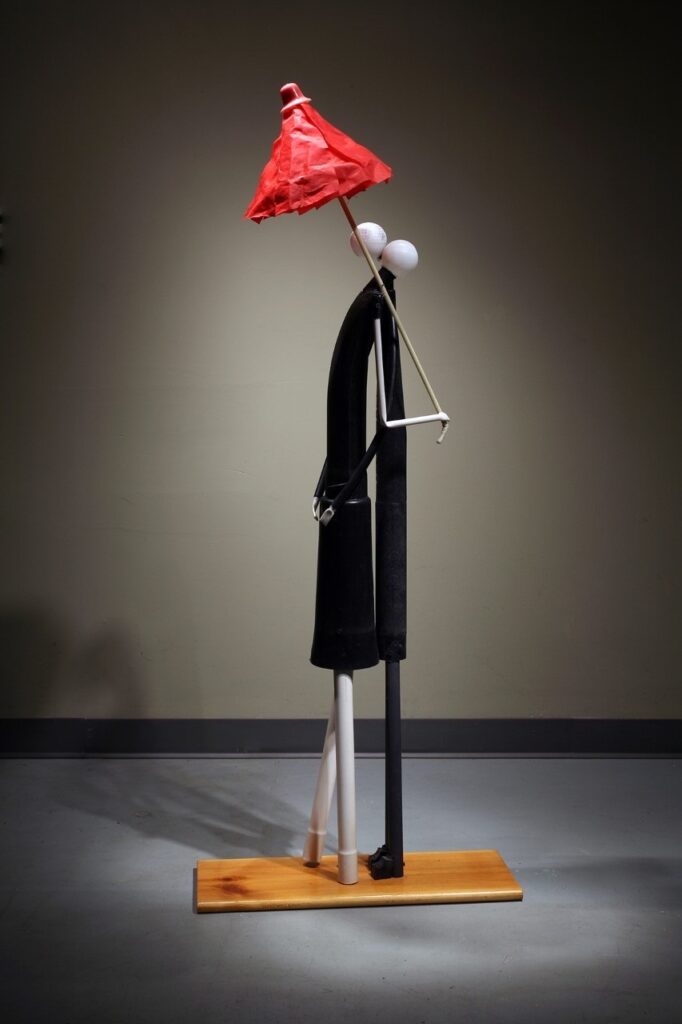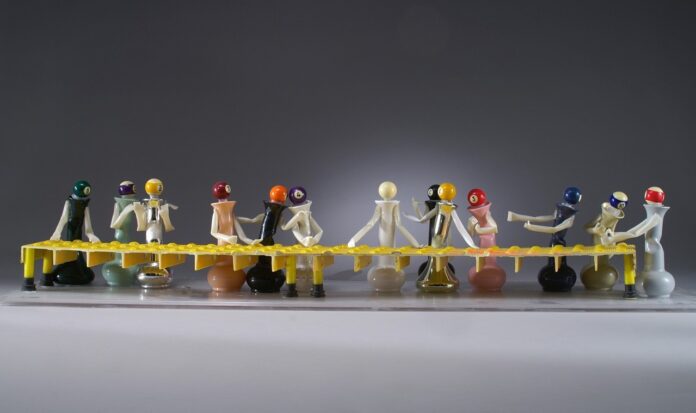Two words: Plastic Man. Such is the moniker of Jerry Ross Barrish, the sculpture artist who breathes new life into found materials that he says belong to, “the lowest caste in the hierarchy of debris.” His figurative tableaus are throwaways reborn through a keen eye that sees a story where others see junk.
A fourth-generation San Franciscan, Barrish grew up in the Sunset and graduated from Abraham Lincoln High School in the class of 1957. After a stint in the Army stationed in Germany, Barrish returned to establish himself as a bail bondsman, coming to the aid of student protestors arrested in civil rights and anti-war demonstrations across the Bay Area in the ’60s.
Since 1980, he has lived in Pacifica while maintaining a sculpture studio, now located in an old Mission District warehouse. Since 2021, Barrish has been hard at it in 33 Bartlett Street, which also serves as a showroom.
“I started as an art collector in the 1960s and saw so much bad art, I thought I’d give it a try myself,” he told 48hills.

Around 1968, Barrish got involved in a traditional sculpture practice at the studio of C.B. Johnson in Bernal Heights. A year later, he received a letter from the Army informing him that if he didn’t use his GI Bill within five years, the benefits would expire. That’s when he applied to the San Francisco Art Institute.
“I was accepted, and the first day of classes I changed my focus from sculpture to filmmaking,” Barrish said.
He went on to complete both a BFA (1974) and an MFA (1976) at SFAI. Barrish created independent feature films that he wrote, directed, and sometimes filmed and edited, for 15 years before returning to the medium of sculpture. In 1988, he began making assemblages from found objects, mostly plastic, and has been doing so ever since.
Barrish says he has never experienced artist’s block and inspiration comes from many sources. French filmmaker Claude Lelouche is one artist with whom he feels a kinship, and references the romanticism in Lelouche’s work.
Help us save local journalism!
Every tax-deductible donation helps us grow to cover the issues that mean the most to our community. Become a 48 Hills Hero and support the only daily progressive news source in the Bay Area.
A self-described voyeur, Barrish is an observer of people and searches for discarded materials to replicate what he sees.
“The materials constantly speak to me and I am always on the lookout for something to use,” he said. “I also get inspiration from the title of a song or a movie or even another work of art.”
He works Monday through Friday, and on Saturdays he visits Urban Ore in Berkeley, scavenging for serviceable used goods.
“I started out finding things on the beaches in Pacifica, but it’s folklore that I still get anything there. The beaches are now so clean with weekly community cleanups that there is nothing there for me to pick up,” he said.

Driven by the use of narrative, gesture, and storytelling, Barrish strives for relatability in his work. He constructs his sculptures using adhesives and glues and screws, but his main resource is always plastic.
“At first, I used the plastic as I found it. For some unexplained reason, I restricted myself with self-imposed rules: no cutting, no painting, no bending, etc. Since 2005, I started using spray paint on the pieces to achieve color when needed,” he said. As for determining when a piece is finished, he says it becomes obvious to him when the story he is telling is at the point of, “Happily ever after. The end.”
Since 2021, Barrish has had a series of exhibitions in his showroom on Bartlett. His dear friend, Alida J. Bray, who has extensive education and experience as a curator and museum administrator, became acquainted with his work as an early collector.
“She volunteered to create exhibitions of my sculpture in the space. I didn’t really have a choice in the matter,” he said.
Bray is now on the fourth of seven exhibitions, each carrying a theme. Barrish gives her free reign on subject matter, selection of works, and installation.
“I just get out of the way,” he said.
Most of Barrish’s work is created through his own imagination, though he has made several pieces based on old masterpieces, such as Leonardo da Vinci’s “The Last Supper.” Referring diligently to the iconic painting to get the gestures correct for his own rendition, it took him nearly 10 years to figure out how to make it work.
His piece “Gardenia Girl” (2022) was inspired by an episode of the “Stephen Colbert Show.” One night, the host asked his guests a series of questions such as, do you prefer cats or dogs? Apples or oranges?
“One of the questions was, ‘What’s your favorite smell?’ This made me think about growing up in San Francisco and going downtown with my mother. All the women wore gardenias, and when you got into an elevator, you caught that all-enveloping smell of those flowers. I was probably only eight or nine years old, but it is still one of my favorite smells,” Barrish said.
There is an evolution to his work, both in and out of his control. The arc of Barrish’s creative process has changed from allowing the materials to dictate what the piece would become to making more specific choices. Though he still gets plenty of inspiration from the shape and character of his found objects, he uses them more as a palette in which to execute sculptures from conceived ideas.
“When I look back to when I first started working with all my self-imposed rules, I find the work naive and charming. I can’t go back. I can’t fake naive. The payoff is that now my work is more animated, and my gestures are much more controlled,” Barrish said.

His current work could not have been made 50 years ago—the plastic he finds now didn’t exist. On the flip side, some of the plastic items he used years ago are no longer manufactured.
Barrish makes a clear distinction between art made with found materials versus found objects. His work, he says, is made from miscellaneous stuff, and is not about recognizable objects that contain their own history. His initially-nondescript materials are secondary to the stories he creates with them.
2008’s “Russian Dancer” is one example of a piece whose title emerged after it was completed, cast in bronze from an original assemblage of mostly plastic automotive parts. Encouraged to cast other, larger assemblages in order to allow his work to be displayed outdoors in public areas, he received a commission from the San Francisco Redevelopment Agency to do his first public art piece at Hunters Point Shipyard. The work, “Bayview Horn,” is a 16-foot-tall horn player installed at the intersection of Coleman and Galvez Streets.
Barrish is the subject of the feature-length documentary Plastic Man, the Artful Life of Jerry Ross Barrish. The film by William Farley and Janis Plotkin was completed in 2015 and aired on KQED. It’s currently available on most streaming services. (See a short clip here.)
Recent exhibitions include the Randall Museum in San Francisco through mid-May, and “Protagonist: The Filmic Sculptures of Jerry Ross Barrish,” the inaugural show at MStark Gallery in Half Moon Bay, which ran from January through March. The exhibit was curated by art historian Paris Cotz, who also wrote its accompanying catalogue essay. Barrish is in the group show “Artists/Curators” at Epperson Gallery in Crockett through June 25. Barrish’s studio and gallery showroom at 33 Bartlett Street is open to visitors by appointment only.
Barrish says he has told many people over the years how lucky he is to be able to live a life that he didn’t even know existed when he was young. But curiously, his trajectory has been more intentional than accidental, much like the work itself. He feels fortunate that his pieces are so approachable to both sophisticated artists and young children.
“I make figures like musicians and dancers, and I make objects related to human activity like cameras and cappuccino machines,” he said. “I make flower arrangements. I also make all kinds of animals and birds. Sometimes I just like the challenge of trying to create something from these materials.”
For more information, visit his website at jerrybarrish.com or Barrish’s profiles on Facebook and Instagram.





